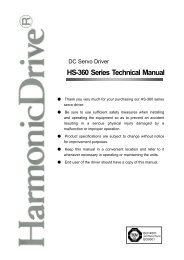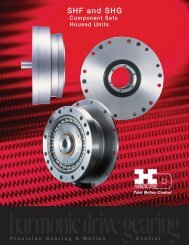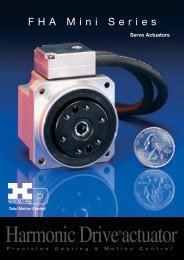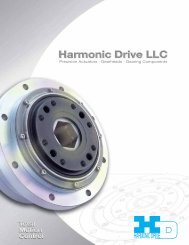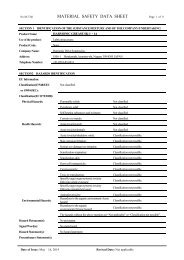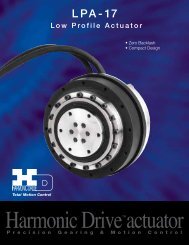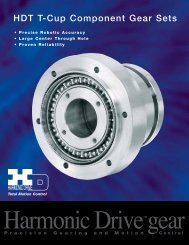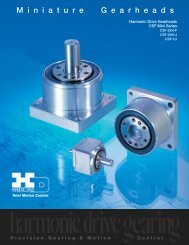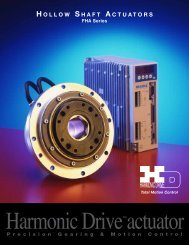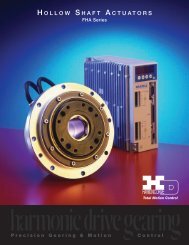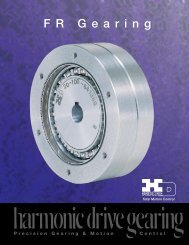CSF CSG PDF - Harmonic Drive LLC
CSF CSG PDF - Harmonic Drive LLC
CSF CSG PDF - Harmonic Drive LLC
- No tags were found...
Create successful ePaper yourself
Turn your PDF publications into a flip-book with our unique Google optimized e-Paper software.
Technical TermsDefinition of RatingsRated Torque (Tr)Rated torque indicates allowable continuous load torque at2000 rpm input speed.Limit for Repeated Peak Torque (refer to figure 1)During acceleration a deceleration the <strong>Harmonic</strong> <strong>Drive</strong>® gearexperiences a peak torque as a result of the moment ofinertia of the output load.Limit for Average TorqueIn cases where load torque and input speed vary, it is necessaryto calculate an average value of load torque. The table indicatesthe limit for average torque. The average torque calculatedmust not exceed this limit.Limit for Momentary Peak Torque (refer to figure 1)The gear may be subjected to momentary peak torques inthe event of a collision or emergency stop. The magnitude andfrequency of occurrence of such peak torques must be kept toa minimum and they should, under no circumstance, occur duringnormal operating cycle. The allowable number of occurrencesof the momentary peak torque may be calculated by usingequation 7 on page 13. Also see section “strength and life”.Figure 1Strength and LifeThe non-rigid Flexspline is subjected to repeated deflections, and itsstrength determines the torque capacity of the <strong>Harmonic</strong> <strong>Drive</strong>® gear.The values given for Rated Torque at Rated Speed and for the allowableRepeated Peak Torque are based on an infinite fatiguelife for the Flexspline.The torque that occurs during a collision must be below themomentary peak torque (impact torque). The maximum numberof occurrences is given by the equation below.[Equation 7]1.0 X 10 4 n: Input speed before collision (r/min)N = ____________2 X n X t t: Time interval during collision (sec)60Please note:If this number is exceeded, the Flexspline may experiencea fatigue failure.Ratcheting phenomenonWhen excessive torque is applied while the gear is in motion,the teeth between the Circular Spline and Flexspline may not engageproperly. This phenomenon is called ratcheting and the torque atwhich this occurs is called ratcheting torque. Ratcheting may causethe Flexspline to become non-concentric with the Circular Spline.(See figure 1 & 2 on page 13) Operating in this condition may resultin shortened life and a Flexspline fatigue failure.Figure 2Abnormal Impact TorqueLoad TorqueNumber of Rotationsof Wave GeneratorStartRoutineStopSpeed CycleStartTimeLoad TorqueRepeated Peak TorqueMomentary Peak TorqueTimeCircular SplineFlexsplineThis condition is called “dedoidal”.Maximum Input Speed, Limit for average input speedDo not exceed the allowable rating.Moment of InertiaThe rating indicates the moment of inertia reflected to thewave generator (gear input).Note!When ratcheting occurs, the teeth mesh abnormally as shown above.Vibration and Flexspline damage may occur.Once ratcheting occurs, the teeth wear excessively and theratcheting torque may be lowered.<strong>Harmonic</strong> <strong>Drive</strong> <strong>LLC</strong> 800-921-333213




